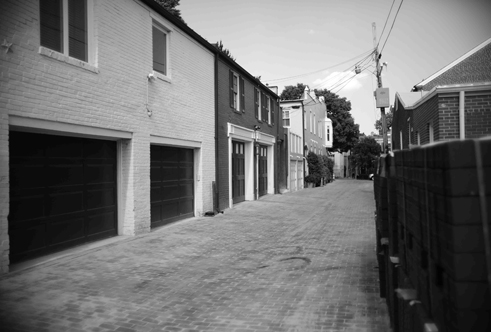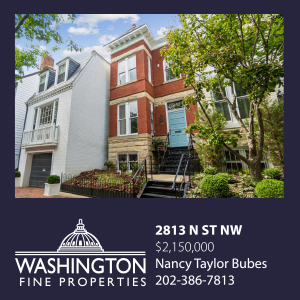New Survey Highlights District’s Historic Alleys

By Katie PearceCurrent Staff Writer
Despite its usual vigilance in documenting and preserving its historic buildings, D.C. is only now starting to account for hundreds of structures concealed from plain view — the old stables, homes, warehouses and garages that line its back alleys.The first formal attempt to survey these buildings, launched in 2011, is now detailed in a new report from the D.C. Historic Preservation Office.
The effort focuses not only on preservation, but also rediscovery and reinvention of these hidden networks of the city. In the future, the report suggests, D.C.’s alleyways could play host to new types of development, heritage tours, public art, festivals and urban farming, among other opportunities.
The survey documented 1,249 surviving alley structures over 50 years old within established historic districts in and around the L’Enfant city. Of the neighborhoods reviewed, Capitol Hill has the highest concentration of alley buildings, with 519 total. Next are Georgetown (253), Dupont Circle (101) and then U Street (82).
The buildings catalogued — the main types, in order of prevalence, are garages, stables, dwellings, workshops/warehouses, and studios/sheds — date back as far as 1863.
Although their location within neighborhood historic districts provides protections, the alley buildings actually didn’t factor into the formation of those districts. That oversight “was the main impetus for the [new] survey,” said Kim Protho Williams, the architectural historian who led the study.
The exception is the Blagden Alley-Naylor Court area of Shaw, which is recognized as its own historic district due to its intact alley network and collection of old buildings, including 24 former stables. The report notes that this area is seeing a renaissance today, as its alleyways thrive with residences, restaurants and shops.
Naylor Court resident David Salter, who runs a blog called “Preserving DC Stables,” helped push for the launch of the city’s survey. He said the documentation makes D.C. alley structures “more protected than they were before” and also heightens awareness of “new areas for people to live in and develop” in the increasingly dense city. “New residents are just starting to venture into the alleys, saying, ‘I never knew this existed.’”
Salter said in his own alley neighborhood, redevelopment has been “like a slingshot” following the recession. But an active preservation-minded community has steered developers and architects “to design things that are sensitive to the alley,” he said.
The new report also points to the reactivation of Cady’s Alley in Georgetown, where the “formerly under-utilized collection of 19th century stables, warehouses and alley dwellings has been converted into an exclusive shopping district.”
The alley structures remaining today in D.C. reveal only a shade of the city’s broader history with alleyways, which the report recounts in detail.
Starting out as a way to increase housing options and landlord incomes in a growing city, D.C.’s alleyways transformed after the Civil War into slum areas housing predominantly African-American residents. These neighborhoods, lacking adequate sewer and water connections, were known for their substandard conditions. In 1904, President Theodore Roosevelt denounced the alleyways as “breeding grounds of vice and disease.”
Over the years several formal efforts were launched to condemn and eradicate alley buildings. In 1934 Congress established the Alley Dwelling Authority, which aimed to clear all D.C. alley homes of their occupants within a decade. The advent of World War II ultimately derailed that goal, and the act was later repealed due to the activism of affluent white residents then living in renovated alley homes in Georgetown, Capitol Hill and Foggy Bottom.
The new survey found 108 alley buildings that originally served as residences — most in the aforementioned neighborhoods. Williams noted that this is only a 3 percent survival rate, based on figures from a 1912 survey. One notably intact cluster remains in Foggy Bottom, along Snows Court and Hughes Mews.
Looking forward, the Historic Preservation Office hopes to expand its survey to more areas outside of the L’Enfant Plan, including Sheridan-Kalorama and Mount Pleasant; and beyond that to neighborhoods like Petworth and Bloomingdale that aren’t formally recognized as historic. (Williams mentioned that a number of alley residents in Bloomingdale have been talking about pursuing their own historic district.)
Williams also said she’d like to see a website or virtual tour devoted to the District’s alleyways.
From an urban planning perspective, the report lays out various recommendations, including activating the spaces for uses like art, street fairs and community gardens. To increase the visibility of alleyways, the report suggests granting them all official names and signage, and promoting tourism opportunities.
Williams said inspiration for such approaches comes from other U.S. cities working to activate historic alleyways, such as San Francisco, Los Angeles and Denver.
The D.C. report also points to eight areas that could serve as targeted “case studies” for alley revitalization. Those include St. Matthew’s Court in Dupont Circle, Congress Court/Oak Alley in Georgetown, and “Square 242” near 14th Street.
The full survey is available online at tinyurl.com/dcalleysurvey or through the D.C. Office of Planning’s website, planning.dc.gov.
This article appears in the May 14 issue of The Georgetown Current newspaper.





